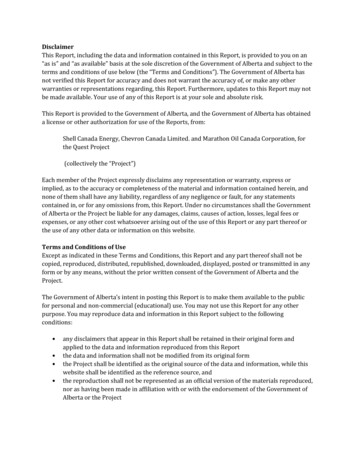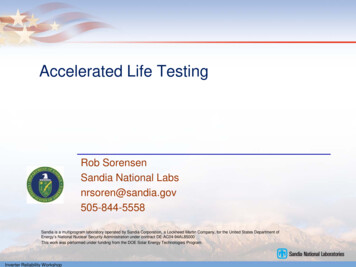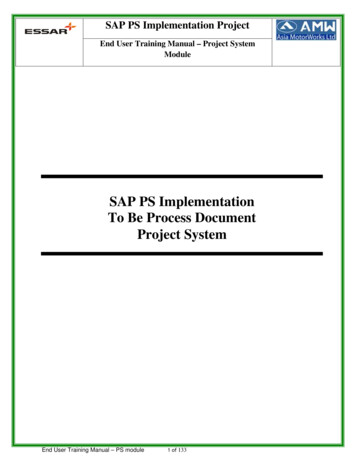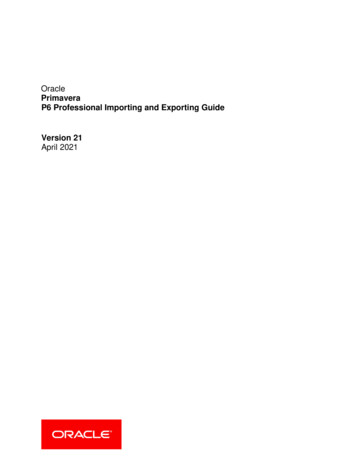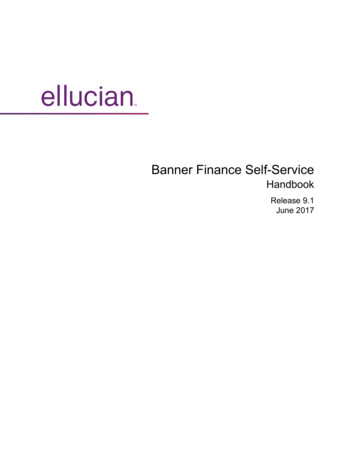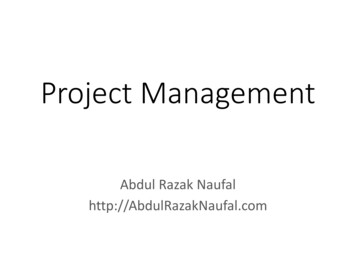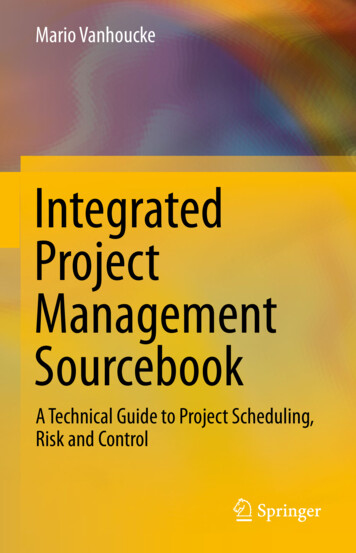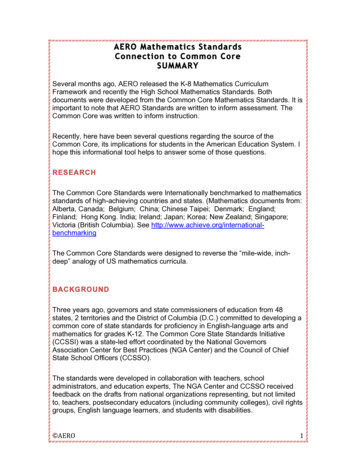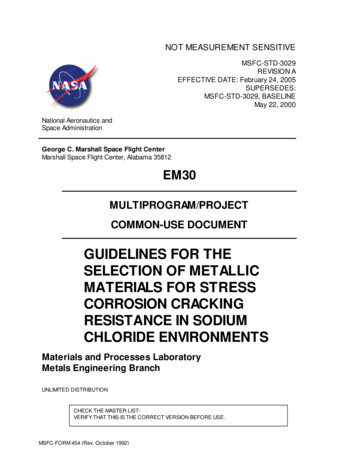
Transcription
NOT MEASUREMENT SENSITIVEMSFC-STD-3029REVISION AEFFECTIVE DATE: February 24, 2005SUPERSEDES:MSFC-STD-3029, BASELINEMay 22, 2000National Aeronautics andSpace AdministrationGeorge C. Marshall Space Flight CenterMarshall Space Flight Center, Alabama 35812EM30MULTIPROGRAM/PROJECTCOMMON-USE DOCUMENTGUIDELINES FOR THESELECTION OF METALLICMA TERIALS FOR STRESSCORROSION CRACKINGRESISTA NCE IN SODIUMCHLORIDE ENVIRONMENTSMaterials and Processes LaboratoryMetals Engineering BranchUNLIMITED DISTRIBUTIONCHECK THE MASTER LISTVERIFY THAT THIS IS THE CORRECT VERSION BEFORE USE.MSFC-FORM 454 (Rev. October 1992)
Multiprogram/Project Common-Use DocumentEM30Guidelines for the Selection of Metallic Materials for StressMSFC-STD-3029Corrosion Cracking Resistance in Sodium ChlorideDate: February 24, 2005EnvironmentsRevision: APage 2 of 45DOCUMENT HISTORY ionDocumentRevisionEffectiveDateMay 22, 2000AFebruary 24,2005DescriptionThis standard supersedes MSFC-SPEC-522B, which was issued in July1, 1987.This version supersedes the baseline, which was published in May 22,2000.Check the master list. Verify that this is the correct version before use.
Multiprogram/Project Common-Use DocumentEM30Guidelines for the Selection of Metallic Materials for StressMSFC-STD-3029Corrosion Cracking Resistance in Sodium ChlorideDate: February 24, 2005EnvironmentsRevision: APage 3 of 45FOREWORDMSFC-STD-3029 evolved from MSFC-SPEC-522B ("Design Criteria for Controlling StressCorrosion Cracking"), which was originated as a tool to control stress corrosion crackingthroughout NASA programs. The purpose of this document is to provide guidelines todesigners regarding materials selection for stress corrosion resistance and to present therequirements for the approval of materials with moderate or high susceptibility.In this revision of MSFC-STD-3029 the austenitic stainless steels CRES 303 and 303Se(free machining steels of the 300 series) have been removed from Table III. These alloyshad been classified as highly susceptible to stress corrosion as a conservative approachto recommendations received during the NASA-wide review of the document. Additionaltesting indicated that these alloys are not susceptible to stress corrosion cracking in asodium chloride environment at a neutral pH. Therefore, along with other stainless steelsof the 300 series (in the unsensitized condition) they are classified as a group in Table I(highly resistant) in this version of the document.Request for information, corrections, or additions to this document shall be directed toThe Materials and Processes Laboratory, Metals Engineering Branch, EM30, MarshallSpace Flight Center, Huntsville, Al 35812.Pablo D. TorresMetallic Materials Engineering TeamNASA MSFCVoice: 205-544-2616Fax: 256-544-5877pablo.d.torres@nasa.govCheck the master list. Verify that this is the correct version before use.
Multiprogram/Project Common-Use DocumentEM30Guidelines for the Selection of Metallic Materials for StressMSFC-STD-3029Corrosion Cracking Resistance in Sodium ChlorideDate: February 24, 2005EnvironmentsRevision: APage 4 of 45TABLE OF CONTENTSPARAGRAPHPAGEDOCUMENT HISTORY LOG . 2FOREWORD . 3TABLE OF CONTENTS. 4LIST OF FIGURES . 6LIST OF TABLES . 6LIST OF APPENDICES. 61. SCOPE. 71.1 PURPOSE. 71.2 APPLICABILITY . 72. APPLICABLE DOCUMENTS. 72.1 GOVERNMENT DOCUMENTS. 72.2 AMERICAN SOCIETY FOR TESTING AND MATERIALS (ASTM) DOCUMENTS. 72.3 ORDER OF PRECEDENCE. . 83. DEFINITION. 83.1 STRESS CORROSION. 84. GENERAL REQUIREMENTS. 84.1 L IMITATIONS . 84.1.1 Temperature and Environment Limitations. 84.1.2 Weldments. 94.1.3 Specific Test Data. 94.1.4 Data Limitations. 94.2 GRAIN ORIENTATION . . 94.2.1 Processing Operations. . 94.2.1.1 Rolling and Extruding. . 94.2.1.2 Forgings.104.2.2 Short Transverse Direction. .104.3 STRESS CONSIDERATIONS . .104.3.1 Examples of Assembly Stresses. .104.3.2 Examples of Residual Stresses.104.4 SUSCEPTIBILITY OF ENGINEERING ALLOYS .104.4.1 Aluminum Alloys. .104.4.1.1 Mechanical Stress Relief.114.4.1.2 Machining Wrought Aluminum. .114.4.2 Ferrous Alloys.114.4.3 Nickel Alloys.114.4.4 Copper Alloys. .11Check the master list. Verify that this is the correct version before use.
Multiprogram/Project Common-Use DocumentEM30Guidelines for the Selection of Metallic Materials for StressMSFC-STD-3029Corrosion Cracking Resistance in Sodium ChlorideDate: February 24, 2005EnvironmentsRevision: APage 5 of 454.4.5 Titanium Alloys. .115. DETAILED REQUIREMENTS.125.1 TESTING OF METALLIC MATERIALS FOR STRESS CORROSION SUSCEPTIBILITY .125.1.1 Test Specimens.125.1.2 Chemical Composition of the Test Materials.125.1.3 Hardness Tests. .125.1.4 Mechanical Properties of the Test Materials. .125.1.5 Stressing and Exposure of Specimens to the Test Environment(s): .135.1.6 Determination of Reduction in Load Carrying Ability. .135.1.7 Test Environments. .135.1.7.1 Alternate Immersion in 3.5-Percent Sodium Chloride Solution per ASTM G44.135.1.7.2 Five-Percent Salt Spray Per ASTM B117.135.1.7.3 High Humidity. .145.1.7.4 Seacoast Environment.145.1.7.5 Slow Strain Rate per ASTM G129. .145.1.7.6 New Techniques For Stress Corrosion Testing. .145.1.8 Test Duration. .145.1.9 Verification of Stress Corrosion Failures. .155.1.10 Reporting of Results.155.2 RATING OF ALLOYS FOR STRESS CORROSION SUSCEPTIBILITY .155.2.1 Stress Corrosion Ratings Based on Alternate Immersion or Salt Spray Tests. .155.2.1.1 Table I Requirements. .155.2.1.2 Table II Requirements. .155.2.1.3 Table III Requirements. .165.2.2 Stress Corrosion Ratings Based on Less Conventional Tests.165.2.3 Stress Corrosion Ratings Based on Service Experience.165.2.4 Criteria For Accepting Stress Corrosion Ratings Based On Data Obtained From OtherLaboratories. .165.3 U SE OF STRESS CORROSION RATINGS I N DESIGN TO PREVENT FAILURES . .165.3.1 Materials Selection Criteria.165.3.1.1 Table I Alloys. .165.3.1.2 Table II Alloys. .175.3.1.2.1 High Installation Stresses. .175.3.1.2.2 Aluminum Alloy Sheet Material. .175.3.1.3 Table III Alloys. .175.3.2 Request For Materials Approval Prior to Use, Assembly, or Integration. .175.4 ASSESSMENT OF THE POTENTIAL FOR A STRESS CORROSION FAILURE . .175.5 THE MATERIALS U SAGE AGREEMENT (MUA).195.6 U NLISTED MATERIALS.205.7 PROTECTIVE COATINGS .205.8 SURFACE TREATMENTS. .206. NOTES .216.1 I NTENDED U SE.216.2 CAUTION AGAINST MISAPPLICATION OF THIS DOCUMENT.216.3 KEYWORDS.21Check the master list. Verify that this is the correct version before use.
Multiprogram/Project Common-Use DocumentEM30Guidelines for the Selection of Metallic Materials for StressMSFC-STD-3029Corrosion Cracking Resistance in Sodium ChlorideDate: February 24, 2005EnvironmentsRevision: APage 6 of 45LIST OF FIGURESFIGURETITLEPAGE1. GRAIN ORIENTATION I N STANDARD WROUGHT FORMS. .222. EXAMPLES OF TENSILE STRESSES I N SHORT TRANSVERSE DIRECTION APPLIED DURING ASSEMBLY. .233. EXAMPLES OF TENSILE STRESSES I N SHORT TRANSVERSE DIRECTION RESULTING FROM ASSEMBLY. .244. TYPICAL RESIDUAL STRESS DISTRIBUTION IN 7075 ALUMINUM ALLOY SHAPES.255. TYPICAL STRESS CORROSION ASSEMBLIES. .266. TYPICAL EQUIPMENT U SED FOR STRESS CORROSION EVALUATIONS .277. TYPICAL SCANNING ELECTRON MICROSCOPE VIEWS OF A STRESS CORROSION CRACKING FAILURE .288. TYPICAL METALLOGRAPHIC VIEWS OF A STRESS CORROSION CRACKING FAILURE . .29LIST OF TABLESTABLE I. ALLOYS WITH HIGH RESISTANCE TO STRESS CORROSION CRACKING IN SODIUMCHLORIDE ENVIRONMENTSI-A. FERROUS ALLOYS .30I-B. ALUMINUM ALLOYS .31I-C. COPPER ALLOYS .32I-D. NICKEL ALLOYS.33I-E. MISCELLANEOUS ALLOYS.34TABLE II. ALLOYS WITH MODERATE RESISTANCE TO STRESS CORROSION CRACKING IN SODIUMCHLORIDE ENVIRONMENTSII-A. FERROUS ALLOYS .35II-B. MAGNESIUM ALLOYS.35II-C. ALUMINUM ALLOYS.36TABLE III. ALLOYS WITH LOW RESISTANCE TO STRESS CORROSION CRACKING IN SODIUMCHLORIDE ENVIRONMENTSIII-A. FERROUS ALLOYS .37III-B. ALUMINUM ALLOYS .38III-C. COPPER ALLOYS .39III-D. MAGNESIUM ALLOYS.39LIST OF APPENDICESAPPENDIXPAGEAPPENDIX A. Stress Corrosion References.40APPENDIX B. Concluding Material.45Check the master list. Verify that this is the correct version before use.
Multiprogram/Project Common-Use DocumentEM30Guidelines for the Selection of Metallic Materials for StressMSFC-STD-3029Corrosion Cracking Resistance in Sodium ChlorideDate: February 24, 2005EnvironmentsRevision: APage 7 of 451. SCOPE1.1 PURPOSE.This document defines the design criteria that shall be used for the selection of metallicmaterials in order to prevent failure due to stress corrosion cracking.1.2 A PPLICABILITY.The exposure environment is limited to alternate immersion in salt water, salt fog,seacoast, and slow strain rate in a salt solution. Alloys used for electrical wiring and othersimilar nonstructural electrical or electronic applications are exempt from therequirements of this document.2. APPLICABLE DOCUMENTS2.1 GOVERNMENT DOCUMENTS.2.1.1 MSFC-STD-506, "Material and Process Control Standard"2.1.2 MSFC-Form-551, "Materials Usage Agreement Form"2.2 A MERICAN SOCIETY FOR TESTING A ND MATERIALS (ASTM) DOCUMENTS.2.2.1 ASTM B117, “Standard Practice For Operating Salt Spray (Fog) Apparatus”2.2.2 ASTM G30, “Standard Practice For Making and Using U-Bend Stress Corrosion TestSpecimens”2.2.3 ASTM G38, “Standard Practice For Making and Using C-Ring Stress Corrosion TestSpecimens”2.2.4 ASTM G39, “Standard Practice For Preparation and Use of Bent-Beam StressCorrosion Test Specimens”2.2.5 ASTM G44, “Standard Practice For Evaluating Stress CorrosionCracking Resistance of Metals and Alloys by Alternate Immersion in 3.5-Percent SodiumChloride solution"2.2.6 ASTM G47, “Standard Test Method For Determining Susceptibility to StressCorrosion Cracking of 2XXX and 7XXX Aluminum Alloy Products”2.2.7 ASTM G49, “Standard Practice For Preparation and Use of DirectTension Stress Corrosion Test Specimens”Check the master list. Verify that this is the correct version before use.
Multiprogram/Project Common-Use DocumentEM30Guidelines for the Selection of Metallic Materials for StressMSFC-STD-3029Corrosion Cracking Resistance in Sodium ChlorideDate: February 24, 2005EnvironmentsRevision: APage 8 of 452.2.8 ASTM G58, “Standard Practice For Preparation of Stress Corrosion TestSpecimens for Weldments”2.2.9 ASTM G64, “Standard Classification of the Resistance to Stress Corrosion Crackingof Heat-Treatable Aluminum Alloys”2.2.10 ASTM G129, "Standard Practice For Slow Strain Rate Testing to Evaluate theSusceptibility of Metallic Materials to Environmentally Assisted Cracking"2.3 ORDER OF PRECEDENCE.In case of a conflict between the text of this document and the references cited herein, thetext of this document takes precedence. The content of this document, however, doesnot supersede applicable laws and regulations unless a specific exemption has beenobtained. The latest issue in effect of this document shall be used.3. DEFINITION3.1 STRESS CORROSION.Stress corrosion may be defined as the combined action of sustained tensile stress andcorrosion to cause premature failure of a susceptible material. Certain metallic materialsare more susceptible than others. If a susceptible material is placed in service in acorrosive environment under tension of sufficient magnitude, and the duration of service issufficient to permit the initiation and growth of cracks, failures can occur at a stress lowerthan the material would normally be expected to withstand. The corrosive environmentneed not be severe in terms of general corrosive attack. Service failures due to stresscorrosion are frequently encountered for which the surfaces of the failed parts are notvisibly corroded in a general sense. If failure of a susceptible material in a corrosiveenvironment is to be avoided, the total tensile stress (residual and applied) in service is tobe maintained at a safe level. Comparative stress corrosion thresholds can bedetermined for metallic materials under certain controlled test conditions. It isrecommended that estimates of the stress corrosion threshold for a specific serviceapplication be determined for each alloy and heat treatment using a test piece, stressingprocedure, and corrosive environment that are appropriate for the intended service.4. GENERAL REQUIREMENTS4.1 LIMITATIONS.4.1.1 Temperature and Environment Limitations.The stress corrosion susceptibility of the alloys included in this document was determinedat ambient temperature by conducting stress corrosion tests or by service experiencewith fabricated hardware. The majority of the stress corrosion tests were performed byexposing specimens to either 3.5-percent alternate immersion per ASTM G44 or 5percent salt spray per ASTM B117. In many occasions, parallel tests were performed in aCheck the master list. Verify that this is the correct version before use.
Multiprogram/Project Common-Use DocumentEM30Guidelines for the Selection of Metallic Materials for StressMSFC-STD-3029Corrosion Cracking Resistance in Sodium ChlorideDate: February 24, 2005EnvironmentsRevision: APage 9 of 45seacoast environment or in a high humidity cabinet. Some data generated with the slowstrain rate technique also involved the use of a sodium chloride solution as the corrodingagent. Use of the criteria established herein shall be limited to designs for serviceinvolving similar exposure conditions. It is recommended that the behavior of the listedmetallic materials at elevated temperature, and/or in specific chemical environments otherthan those mentioned above, be ascertained by additional testing.4.1.2 Weldments.Weldments present a special problem in designing for resistance to stress corrosioncracking. In addition to the susceptibility of the parent metals, it is also necessary toconsider the filler metal and the microstructural effects of heat and deformation introducedby the welding operations and subsequent thermal treatments. Susceptibility data are notas extensive for weldments as for alloys in mill form because of the additional variables tobe considered. Most of the design criteria for weldments in this document are limited toaluminum alloys, selected stainless steels in the 300 series, and other specific alloyslisted in Table I.4.1.3 Specific Test Data.This document is intended to provide general criteria to be used in designing forresistance to stress corrosion cracking. Specific test data and other detailed informationare not included. However, a list of references is attached as Appendix A from whichadditional information can be obtained.4.1.4 Data Limitations.This document does not purport to be all inclusive of factors and criteria necessary for thetotal control of stress corrosion cracking in alloys. Data on stress corrosion susceptibilitymay be insufficient for many applications involving unfamiliar materials or unusualcombinations of materials and environments. To ensure adequate stress corrosionresistance in these situations, it is necessary to conduct a detailed evaluation ofsusceptibility. Testing may also be necessary in those cases.4.2 GRAIN ORIENTATION.4.2.1 Processing Operations.Rolling, extruding, and forging are the most common processing operations employed inthe production of standard wrought forms of metal. All produce a flow of metal in apredominant direction so that, microscopically, the metal is no longer isotropic. As aresult, the properties of the metal vary according to the direction in which they aremeasured. The extent of directional variation depends on the property of interest. Forsusceptibility to stress corrosion cracking, the directional variation can be appreciable andis considered in the design of fabricated hardware.4.2.1.1 Rolling and Extruding.The anisotropy of grain orientation produced by rolling and extruding is illustratedschematically in Figure 1. Taking the rolled plate as an example, it is conventional todescribe grain orientation in three directions. The direction of rolling is the longitudinaldirection, the direction perpendicular to the longitudinal and in the plane of the plate is theCheck the master list. Verify that this is the correct version before use.
Multiprogram/Project Common-Use DocumentEM30Guidelines for the Selection of Metallic Materials for StressMSFC-STD-3029Corrosion Cracking Resistance in Sodium ChlorideDate: February 24, 2005EnvironmentsRevision: APage 10 of 45long transverse direction, and the direction through the thickness of the plate is the shorttransverse direction. For certain shapes, the simple rules may not apply and grainorientation can only be established by experience with the shape and knowledge of theforming methods. As an example, consider the thick tee section illustrated in Figure 2.4.2.1.2 Forgings.Identifying the short transverse direction of forgings also r
MSFC-STD-3029 evolved from MSFC-SPEC-522B ("Design Criteria for Controlling Stress Corrosion Cracking"), which was originated as a tool to control stress corrosion cracking throughout NASA programs. The purpose of this document is to provide guidelines to designers regarding materials selection for stress corrosion resistance and to present the
